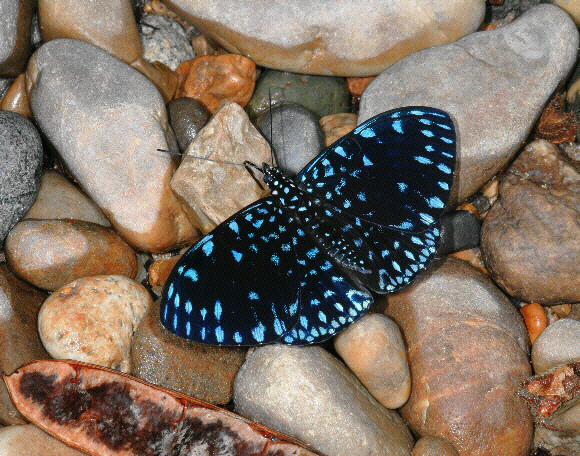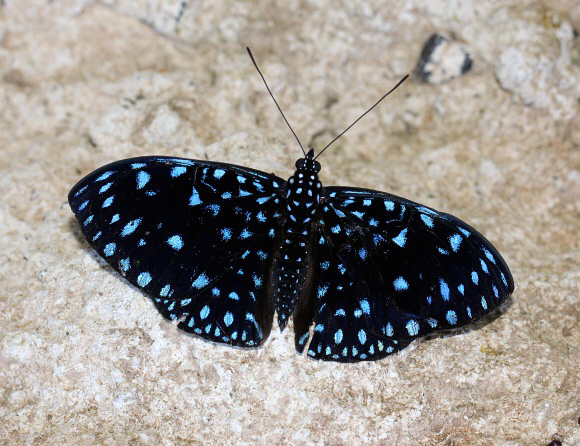 Hamadryas laodamia, male, Rio Madre de Dios, Peru – Adrian Hoskins
Hamadryas laodamia, male, Rio Madre de Dios, Peru – Adrian Hoskins
Introduction
There are 20 members of the genus Hamadryas. Most are found only in Central and South America, although 8 have been recorded sporadically in the southern USA.
The butterflies are commonly known as Crackers due to the ability of the males of several species to produce a sound similar to the crackling of bacon in a frying pan. The sound is produced as the butterflies take off, and is made by twanging a pair of spiny rods at the tip of the abdomen against bristles on the anal claspers. Only males can produce the sound, but both sexes can detect it – their wings have tiny hollow cells covered in membranes that vibrate in response to sound, and stimulate nerve endings. The purpose of the sound is not known. It may possibly deter competing males from occupying the same territory, or could act as a trigger to initiate the first response from a female during courtship.
All Hamadryas species have a beautiful calico pattern on the upperside. In many there is a series of submarginal ocelli on the hindwings, and distinct kidney-shaped stigmata in the discal cells of fore and hind wings. In several species such as februa and glauconome the ground colour is greyish and the pattern acts as an extremely effective camouflage against the bark of trees. In others such as amphinome, laodamia and velutina the wings are velvety black with a blue sheen and a pattern of bright blue spots.
Photographing Hamadryas can be a frustrating experience, as both sexes spend most of their time basking high up on tree trunks, often 10 metres or more above the ground. They sit there for hours with wings outspread, always facing downwards to keep a watchful eye for potential mates. At times they descend and bask much lower down, at a height of just a couple of metres, but at the slightest disturbance they immediately fly back to the tree top. They remain there until the intruder has left the vicinity, and then descend the tree trunk in a series of short hopping flights, dropping a short distance each time until after half an hour or so they have resumed their original position.
It is unusual to see the butterflies on the ground. I spotted the butterfly in the above photo imbibing moisture at the edge of a small rocky stream in Peru, surrounded by 50 or 60 Panacea prola and an assortment of other species including Jemadia hewitsonii, Adelpha jordani, and the beautiful day-flying moths Urania leilus and Xanthiris flaveolata. As I approached, the Panacea fanned their wings displaying their bright red undersides, which acted as an alarm signal causing the entire swarm of butterflies to become airborne. After several minutes many of the butterflies including the laodamia returned, and I made another very cautious approach. Again the Panacea wing-fanning panicked all the butterflies took to the air. After several other unsuccessful approaches over a period of 2 hours or more, and with rain beginning to fall, I had almost given up hope of a photograph, but was lucky to squeeze off a single shot of this beautiful insect from a distance of about 2 metres. Ten seconds later the rain came pelting down and the butterflies all disappeared.
The common name Starry Night is derived from the painting by Vincent van Gogh.
Hamadryas laodamia is distributed from Mexico to Peru.
Habitats
This species is confined to primary rainforest at altitudes between sea level and about 900 metres.
Lifecycle
The eggs are white, and laid in chains of up to a dozen, hanging from the underside of leaves. The fully grown larvae are reddish brown with a pale green band along the back and a broad white band above the spiracles. They have short rosetted spines along the back and a pair of longer spines on segments 3 and 10. The head bears a pair of long green horns. The larvae feed on Dalechampia triphylla ( Euphorbiaceae ). The pupa resembles a small withered leaf, and is pale brown in colour with a pair of flattened curly head processes. It is suspended by the cremaster from a leaf or stem.
Adult behaviour
Hamadryas laodamia is often seen basking on tree trunks, adopting a head-downward posture with the wings flattened against the bark. Males bask in this position for long periods to await potential mates. They commonly settle at a height of about 2m but if disturbed immediately take flight. After a few seconds they resettle, usually higher up on the same tree trunk. They remain there until the threat passes, after which they descend the trunk in a series of short flights, dropping lower each time until after several minutes they resume their original position.
The butterflies are active from sunrise to sunset, and are rarely seen away from tree trunks. They feed mainly on decomposing fruit, but as described and illustrated above, they also occasionally settle on the ground to imbibe mineralised moisture, and are also attracted to human sweat.

Hamadryas laodamia, male, Rio Shima, Peru – Adrian Hoskins
